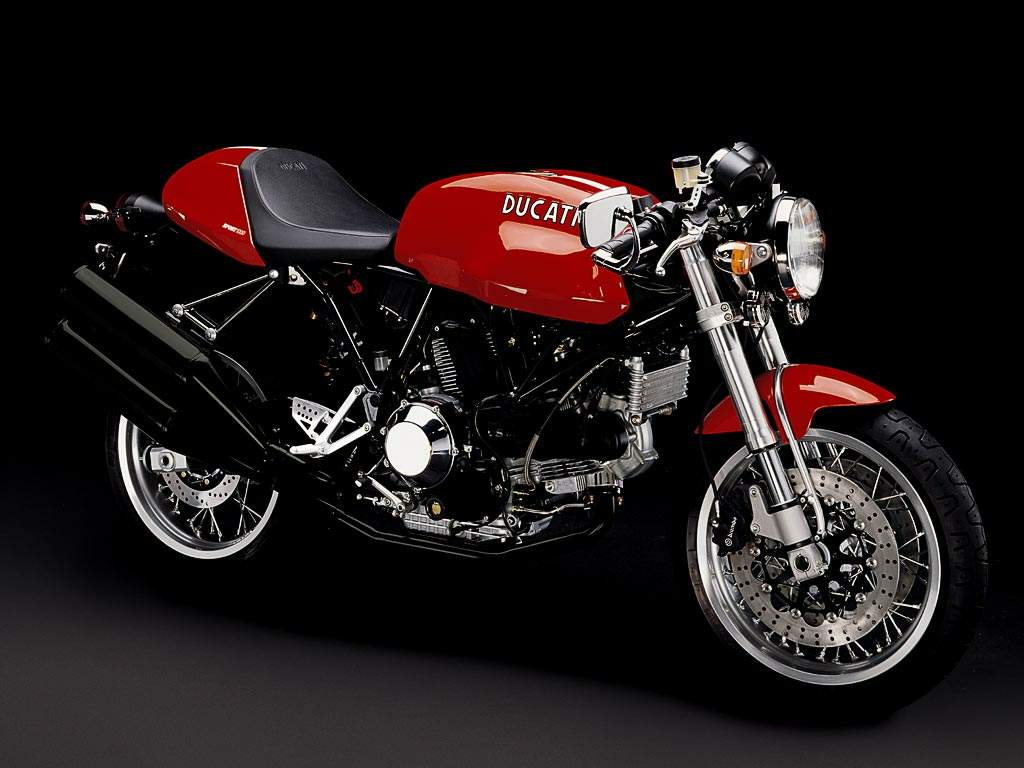
|
|
|
|
|
|
Classic Bikes
Custom Bikes
Individual
Racing Bikes AJP
AJS
Aprilia
Ariel
Avinton / Wakan
Bajaj
Benelli
Beta
Bimota
BMW
Brough Superior
BRP Cam-Am
BSA
Buell / EBR
Bultaco
Cagiva
Campagna
CCM
CF Moto
Combat Motors
Derbi
Deus
Ducati
Excelsior
GASGAS
Ghezzi Brian
Gilera
GIMA
Harley Davidson
Hero
Highland
Honda
Horex
Husaberg
Husqvarna
Hyosung
Indian
Jawa
Kawasaki
KTM
KYMCO
Laverda
Lazareth
Magni
Maico
Mash
Matchless
Mondial
Moto Guzzi
Moto Morini
MV Agusta
MZ / MuZ
NCR
Norton
NSU
Paton
Peugeot
Piaggio
Revival Cycles
Roland Sands
Royal Enfield
Sachs
Sherco
Sunbeam
Suzuki
SWM
SYM
Triumph
TVS
Ural
Velocette
Vespa
Victory
Vincent
VOR
Voxan
Vyrus
Walt Siegl
Walz
Wrenchmonkees
Wunderlich
XTR / Radical
Yamaha
Zero
Video
Technical
Complete Manufacturer List
|
Ducati 1000 Sport Classic Monoposto

Ducati's first big sportbikes - the superbikes of their era - date back to
the early 1970's. They raced and they won; they were the joy of the most
sport-oriented and fanatical riders, and now they are sought-after
collectors' items. Now, as then, they are seen as fine examples of style and
performance, but above all, they are magnificent motorcycles to look at and
to ride.
The 1970's was a period when manufacturers were pouring-out a seemingly endless string of new models. One or two became classics; most went through life unnoticed, and then were forgotten; but no-one ever forgot the gorgeous Ducati big bore race bikes or their road-going counter parts which fuelled the fantasies of a whole generation. This style of bike, a concept of essential purposeful design was an idea
that never really died; it just lay dormant, biding its time until the
moment was ripe to rise again. An essential, racing twin-cylinder, with
lines designed more by the hand of a man than the click of a mouse;
mechanical details boldly in view, harmonious shapes and only the best
componentry: let's face it, they are things of beauty. An agile, lightweight
bike as advanced as this is a joy to ride, especially if it has got a
vibrant, pulsating engine like the twin-cylinder Ducati Desmo. DUCATI SPORTCLASSIC If ever there was a motorcycle manufacturer capable of turning dreams
into reality, it's Ducati.
The new SportClassic family reflects the styling of the motorcycles built in Ducati's workshops in the 1970's, characterised by a minimalist, racing look, with exposed chassis and engines, complimented by bodywork with elegant rounded shapes. To emphasis the unique style and performance origins of the three SportClassics, Ducati has used top-level components styled with original form and finishes, featuring chrome and polished aluminium that provide the final touch, personalise the range and EVOke the lines of the bikes from which they're inspired. New colours and new colour combinations emphasize the original lines of the design. Even though they reflect the best of the past, they incorporate the latest Ducati technology and engineering, creating a thoroughly modern motorcycle that lives-up to today's standards of road-going performance. The Paul Smart L.E., Sport and GT are all powered by the advanced 1000 DS Desmo engine. The torquey air-cooled 90° L-Twin is the perfect match to power these new sport bikes. Slim between the legs and exposed for all to see, the latest two valve Desmo system, fuel-injection and computer controlled engine management ensure that the 1000 DS engine is powerful, dependable and thrilling to ride. Of course, these bikes take advantage of the Ducati tubular Trellis frame that perfectly enhances the beauty of the SportClassics, while delivering confident handling and consistent road manners. With bikes that are as capable as the SportClassics, great brakes are fundamental. High quality Brembo callipers with sintered pads are used, gripping huge 320mm discs up front for strong and consistent stopping power.
The Ducati SportClassics feature distinguishing exclusive components such as beautiful wire spoke wheels laced with alloy rims, black-finish race inspired exhaust systems, unique new swingarms, rear suspension featuring side-mounted shocks, and exposed engine parts with chromed or black painted finishes. DUCATI SPORT 1000 In 1973 the Ducati 750 Sport, which was the predecessor of the Super Sport 750, first appeared in bright yellow paint. With its solo seat and simple single headlamp, the Sport was essentially a production Cafè Racer. Enthusiasts modified and enhanced these bikes to become the "street racer" of the time. The clip-on handlebars, racing stripe down the centre of the tank and solo seat of the Sport 750 anticipated the emerging street performance trend and the Cafè Racer image of the period. The new Ducati Sport 1000 captures the bold Cafè Racer style and essential
beauty of the 70's motorcycles. The bike features a single large diameter
round headlamp and chromed mirrors mounted on the ends of the handlebars,
very much typical of the custom sport bikes of the time. The Sport 1000's suspension features 43mm upside-down forks by Marzocchi, while the rear suspension is handled by a fully adjustable single shock absorber by Sachs
|
|
|
Any corrections or more information on these motorcycles will be kindly appreciated. |